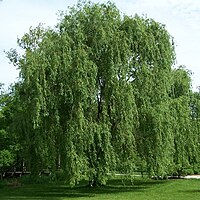
Photo from wikipedia
Willow biomass yields from short-rotation coppice bioenergy systems have been reported across multiple rotations in Europe, USA, and eastern Canada, but data are lacking for the Canadian Prairies. The goal… Click to show full abstract
Willow biomass yields from short-rotation coppice bioenergy systems have been reported across multiple rotations in Europe, USA, and eastern Canada, but data are lacking for the Canadian Prairies. The goal of this study was to evaluate the second rotation biomass yields and stem growth for 30 willow cultivars established in Saskatchewan, Canada in 2007, and coppiced at the end of the first growing season. Detailed stem measurements were collected and all biomass was harvested at the end of the 2010 (first rotation data) and 2013 (second rotation data) growing seasons. The average 3-year cumulative biomass production across all cultivars was 8.1 oven-dry (OD) Mg ha−1 in the second rotation (ranging from 0.6 to 21.3 OD Mg ha−1). The three highest yielding cultivars were Taberg, Tully Champion, and Otisco, with annual production of 6.4–7.1 OD Mg ha−1 year−1 in biomass, which was an increase by 12–44% from the first rotation, and more than double the average for all 30 cultivars (2.7 OD Mg ha−1 year−1), and had an average stool-within-plot survival rate of 81–94%. The 20 lowest clones suffered from higher mortality, which resulted in lower biomass production in the second rotation. These data suggest that the top 10 willow cultivars have a promising potential as a bioenergy source, but more data are needed from the third and successive rotations before a sustainable biomass industry could be established in the Canadian Prairies.
Journal Title: New Forests
Year Published: 2018
Link to full text (if available)
Share on Social Media: Sign Up to like & get
recommendations!